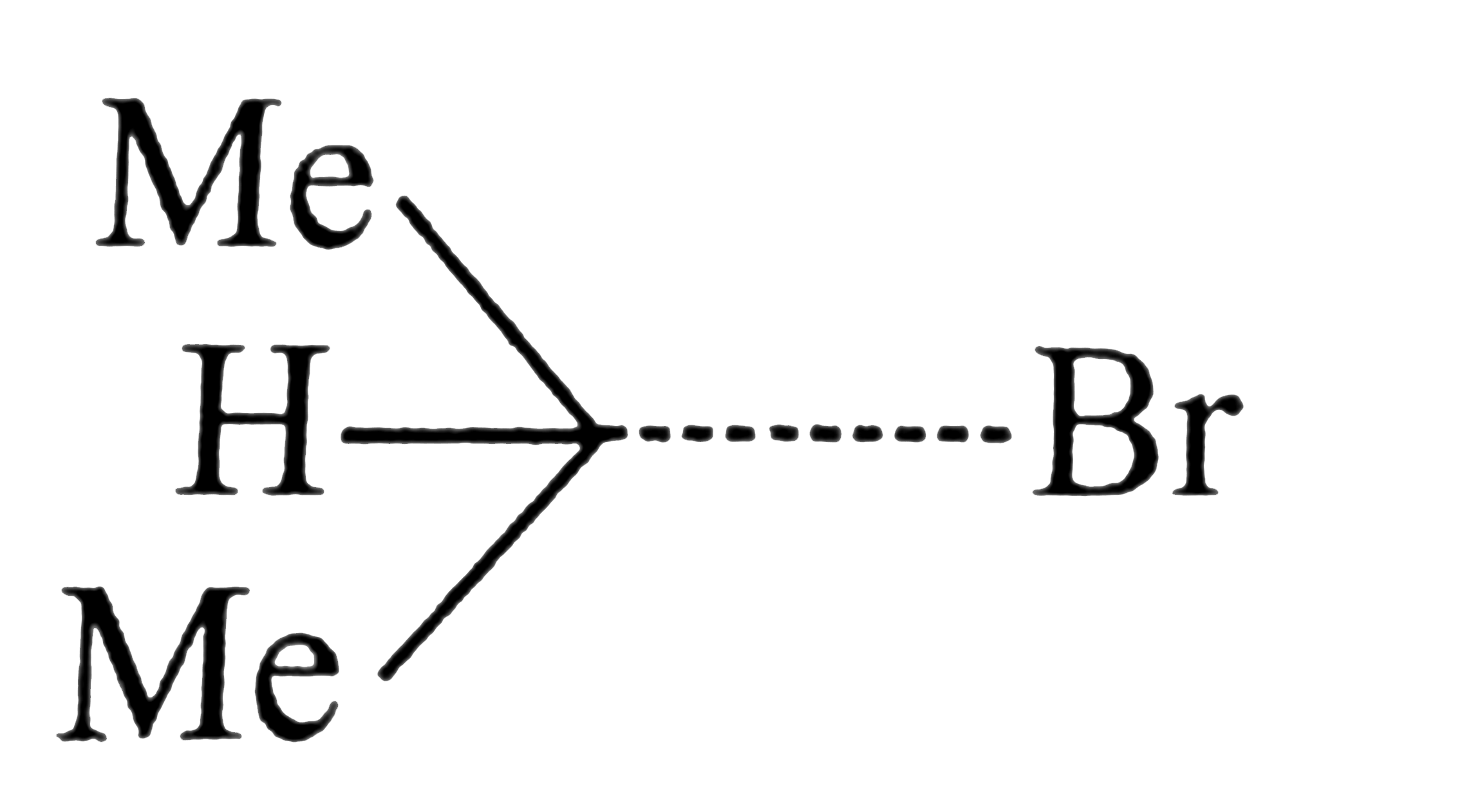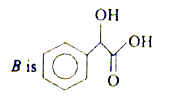IsoprophI bromide was treated separately with sodium ethoxide under two different conditions.
Reaction I:
Treatment of isopropyI bromide with (Me3CONa) at 40∘C gave almost exclusively compound (A)(C3H6).
Reaction II:
Treatment of (i−PrBr) with NaOC2H5 at 30∘C yileled compound (A)(C3H6) along with a small amount of an ether (B)(C5H12O).
Compound (A) was readily oxidised by a neutral solution of cold dil. KMnO4 to give a brown preciptate.
Which of the following most accureately repreasents the activated complex formed in reaction (II) that leads to compound (A) ?




The correct Answer is:d
To solve the question regarding the activated complex formed in reaction II that leads to compound A, we will follow a systematic approach.
1. Identify the Reactants:
- The reactant in reaction II is isopropyl bromide (i-PrBr) and sodium ethoxide (NaOC2H5).
2. Understand the Reaction Conditions:
- The reaction is conducted at 30°C, which suggests that we are likely dealing with a reaction that can proceed via an elimination mechanism rather than substitution due to the presence of a strong base (NaOC2H5).
3. Determine the Product:
- The product A is identified as an alkene (C3H6). Given that isopropyl bromide has two methyl groups, the likely alkene product is propene (C3H6).
4. Mechanism of Reaction:
- The formation of compound A (alkene) from isopropyl bromide and sodium ethoxide suggests an E2 elimination mechanism. In this mechanism, the base (ethoxide ion) abstracts a proton from the β-carbon while the leaving group (bromine) departs from the α-carbon.
5. Identify the Transition State:
- In the E2 mechanism, the transition state involves the simultaneous removal of a hydrogen atom and the departure of the bromine atom. This transition state can be depicted as having partial charges: the ethoxide ion will have a partial negative charge as it is abstracting a proton, and the bromine will have a partial negative charge as it is leaving.
6. Draw the Transition State:
- The transition state can be represented with the isopropyl structure, showing the ethoxide ion attacking the hydrogen on the β-carbon, while the bromine is leaving. The transition state will have a partially formed double bond between the α and β carbons, and the ethoxide ion will be positioned close to the hydrogen being removed.
7. Conclusion:
- Based on the above analysis, the activated complex formed in reaction II that leads to compound A can be accurately represented by the transition state structure that shows the ethoxide ion, the leaving bromine, and the developing double bond.
- The reactant in reaction II is isopropyl bromide (i-PrBr) and sodium ethoxide (NaOC2H5).
- The reaction is conducted at 30°C, which suggests that we are likely dealing with a reaction that can proceed via an elimination mechanism rather than substitution due to the presence of a strong base (NaOC2H5).
- The product A is identified as an alkene (C3H6). Given that isopropyl bromide has two methyl groups, the likely alkene product is propene (C3H6).
- The formation of compound A (alkene) from isopropyl bromide and sodium ethoxide suggests an E2 elimination mechanism. In this mechanism, the base (ethoxide ion) abstracts a proton from the β-carbon while the leaving group (bromine) departs from the α-carbon.
- In the E2 mechanism, the transition state involves the simultaneous removal of a hydrogen atom and the departure of the bromine atom. This transition state can be depicted as having partial charges: the ethoxide ion will have a partial negative charge as it is abstracting a proton, and the bromine will have a partial negative charge as it is leaving.
- The transition state can be represented with the isopropyl structure, showing the ethoxide ion attacking the hydrogen on the β-carbon, while the bromine is leaving. The transition state will have a partially formed double bond between the α and β carbons, and the ethoxide ion will be positioned close to the hydrogen being removed.
- Based on the above analysis, the activated complex formed in reaction II that leads to compound A can be accurately represented by the transition state structure that shows the ethoxide ion, the leaving bromine, and the developing double bond.
Topper's Solved these Questions
- AROMATIC COMPOUNDS AND ALKYL AND ARYL HALIDES BOOK - CENGAGE CHEMISTRY ENGLISHCHAPTER - AROMATIC COMPOUNDS AND ALKYL AND ARYL HALIDES EXERCISE - Exercises Linked Compreshension Type
11 Videos
- AROMATIC COMPOUNDS AND ALKYL AND ARYL HALIDES BOOK - CENGAGE CHEMISTRY ENGLISHCHAPTER - AROMATIC COMPOUNDS AND ALKYL AND ARYL HALIDES EXERCISE - Exercises Multiple Correct
32 Videos
- AROMATIC COMPOUNDS AND ALKYL AND ARYL HALIDES BOOK - CENGAGE CHEMISTRY ENGLISHCHAPTER - AROMATIC COMPOUNDS AND ALKYL AND ARYL HALIDES EXERCISE - Exercises Concept Application
4 Videos
- APPENDIX INORGANIC VOLUME 2BOOK - CENGAGE CHEMISTRY ENGLISHCHAPTER - APPENDIX INORGANIC VOLUME 2EXERCISE - Short Answer Type
179 Videos
- BIOMOLECULESBOOK - CENGAGE CHEMISTRY ENGLISHCHAPTER - BIOMOLECULESEXERCISE - Exercises Archives (Analytical And Descriptive)
8 Videos
Similar Questions
IsoprophI bromide was treated separately with sodium ethoxide under two different conditions.
Reaction I:
Treatment of isopropyI bromide with (Me3CONa) at 40∘C gave almost exclusively compound (A)(C3H6).
Reaction II:
Treatment of (i−PrBr) with NaOC2H5 at 30∘C yileled compound (A)(C3H6) along with a small amount of an ether (B)(C5H12O).
Compound (A) was readily oxidised by a neutral solution of cold dil. KMnO4 to give a brown preciptate.
Which of the following is an accurate representations of compound (B) ?
View SolutionIsoprophI bromide was treated separately with sodium ethoxide under two different conditions.
Reaction I:
Treatment of isopropyI bromide with (Me3CONa) at 40∘C gave almost exclusively compound (A)(C3H6).
Reaction II:
Treatment of (i−PrBr) with NaOC2H5 at 30∘C yileled compound (A)(C3H6) along with a small amount of an ether (B)(C5H12O).
Compound (A) was readily oxidised by a neutral solution of cold dil. KMnO4 to give a brown preciptate.
The formations of (A) and (B) are best explained by:
View Solution
Knowledge Check
Compound 'A' with the formula C3H8O on vigorous oxidation produces an acid C3H6O2. 'A' is
Aa tertiary alcoholBa secondary alcoholCa primary alcoholDnot necessarily an alcoholCompound (A) C8H6O2 on treatment with aq. NaOH followed by acidification gives (B) C3H2O3 which on oxidation gives benzoic acid only:
A B
B C
C D
D
Compound (A) C6H12O3, when treated with I2 in aqueous sodium hydroxide gives yellow precipitate. When A is treated with Tollens reagent no reaction occur. When A is hydrolysed and then treated with Tollens reagent, a silver mirror is formed in test tube. Compound (A) will be :
ACH3−O∣∣C−CH2−CH2−CH∣OCH3−OHBCH3−O∣∣C−OCH3∣C∣OCH3−CH3CCH3−O∣∣C−CH2−CH(OCH3)2DCH3−O∣∣C−CH2−CH2−CH(OCH3)2
IsoprophI bromide was treated separately with sodium ethoxide under two different conditions.
Reaction I:
Treatment of isopropyI bromide with (Me3CONa) at 40∘C gave almost exclusively compound (A)(C3H6).
Reaction II:
Treatment of (i−PrBr) with NaOC2H5 at 30∘C yileled compound (A)(C3H6) along with a small amount of an ether (B)(C5H12O).
Compound (A) was readily oxidised by a neutral solution of cold dil. KMnO4 to give a brown preciptate.
Referring to Q. No. 67 which of the following represents the intermediate T.S for the formation of compound (B) ?
View SolutionAn optically active compound H(C5H6O) on treatment with H2 in the presence of Lindlar's catalyst gave a compound I (C5H8O). Upon hydrogenation with H2 and Pd/C, Compound H gave J (C5H12O). Both I and J were found to b optically inactive. Select the correct statements.
View SolutionOptically active isomer (A) of (C5H9Cl) on treatment with one mole of H2 gives an optically inactive compound (B) compound (A) will be :
View SolutionCompound (A) C5H8O2 liberated CO2 on reaction with sodium bicarbonate. It exists in two forms neither of which is optically active. It yielded compound (B) C5H10O2 on hydrogenation. Compound (B) can be separated into enantiomorphs. Write structures of (A) and (B).
View SolutionA compound X of formula C3H8O yields a compound C3H6O, on oxidation. To which of the following classes of compounds could X being
View Solution
